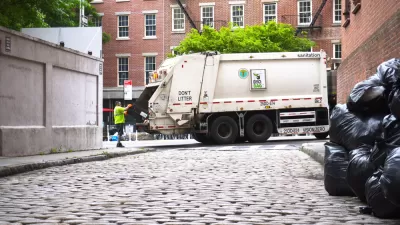This piece from The Economist looks at human-caused waste, how different economies generate it differently, and how they deal with it.
"The amount of waste a community generates tends to grow with its economy (see chart 2). Thus America produces over 700kg of municipal waste per person each year, compared with Nairobi's 220kg. The richer people get, the more paper, plastic and metals they chuck out, so the proportion of food waste goes down. Ash tends to disappear from household waste altogether as electricity and gas replace coal- and wood-fired boilers and stoves."
"Even where plenty of land is available, locals are often hostile to landfills because of the damage they can do to human health and to the environment. Densely packed organic matter produces methane as it rots, which can catch fire or cause explosions. That is also bad for the atmosphere, because methane is a greenhouse gas 21 times more potent than carbon dioxide. The process of decay produces ammonia too, which in sufficient concentrations can poison fish and amphibians and render water undrinkable."
"Yet the main alternative, burning waste, can be just as bad, both for people and for the planet. Smoke from incineration may carry many of the same toxic substances up the chimney and into the atmosphere. Nitrogen and sulphur in the smoke contribute to acid rain, and soot particles cause respiratory problems. In addition, burning organic waste produces chemicals called dioxins and furans, suspected carcinogens which damage the nervous and immune systems, among other ill effects, and are harmful even in minuscule quantities. After burning there is still the ash to be disposed of, usually in a landfill, again with potentially baleful consequences."
FULL STORY: Down in the dumps

Alabama: Trump Terminates Settlements for Black Communities Harmed By Raw Sewage
Trump deemed the landmark civil rights agreement “illegal DEI and environmental justice policy.”

Study: Maui’s Plan to Convert Vacation Rentals to Long-Term Housing Could Cause Nearly $1 Billion Economic Loss
The plan would reduce visitor accommodation by 25% resulting in 1,900 jobs lost.

Planetizen Federal Action Tracker
A weekly monitor of how Trump’s orders and actions are impacting planners and planning in America.

Waymo Gets Permission to Map SF’s Market Street
If allowed to operate on the traffic-restricted street, Waymo’s autonomous taxis would have a leg up over ride-hailing competitors — and counter the city’s efforts to grow bike and pedestrian on the thoroughfare.

Parklet Symposium Highlights the Success of Shared Spaces
Parklets got a boost during the Covid-19 pandemic, when the concept was translated to outdoor dining programs that offered restaurants a lifeline during the shutdown.

Federal Homelessness Agency Places Entire Staff on Leave
The U.S. Interagency Council on Homelessness is the only federal agency dedicated to preventing and ending homelessness.
Urban Design for Planners 1: Software Tools
This six-course series explores essential urban design concepts using open source software and equips planners with the tools they need to participate fully in the urban design process.
Planning for Universal Design
Learn the tools for implementing Universal Design in planning regulations.
Caltrans
Smith Gee Studio
Institute for Housing and Urban Development Studies (IHS)
City of Grandview
Harvard GSD Executive Education
Toledo-Lucas County Plan Commissions
Salt Lake City
NYU Wagner Graduate School of Public Service





























